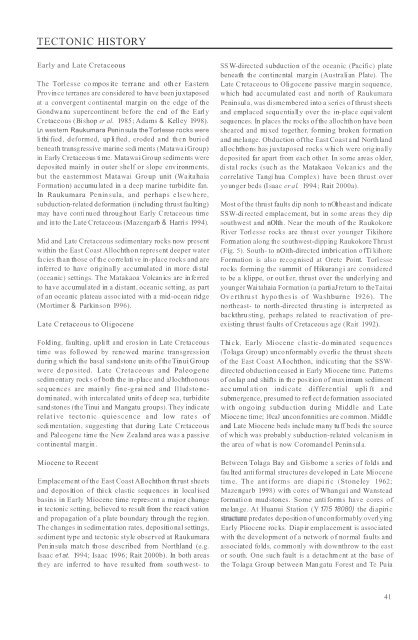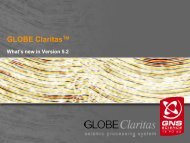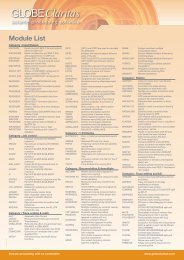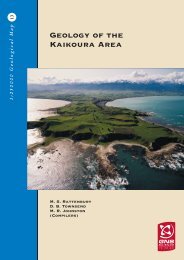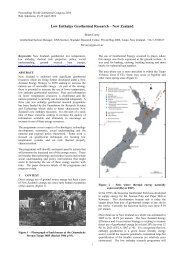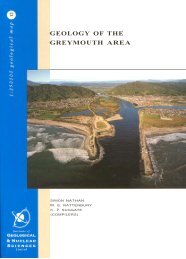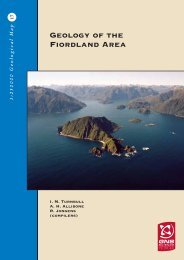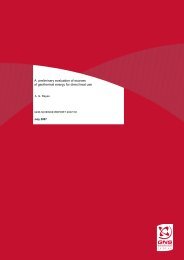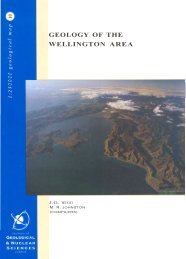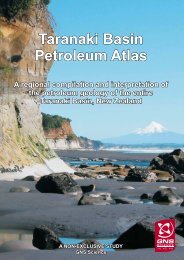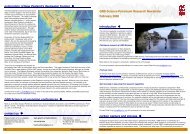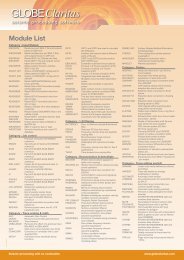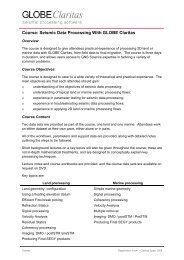GEOLOGY OF THE - GNS Science
GEOLOGY OF THE - GNS Science
GEOLOGY OF THE - GNS Science
Create successful ePaper yourself
Turn your PDF publications into a flip-book with our unique Google optimized e-Paper software.
TECTONIC HISTORYEarly and Late CretaceousThe Torlesse compos ite terrane and oth er EasternProvince terranes are considered to have been juxtaposedat a convergent continental margin on the edge of theGondwana supercontinent before the end of the Earl yCretaceous (Bishop er al. 1985; Adams & Kelley 1998).Ln western Raukumara Peninsula the Torlesse rocks wereli thi fied, deformed, up li fted , eroded and then buriedbeneath transgressive marine sedi ments (Matawai Group)in Early Cretaceous ti me. Matawai Group sediments weredeposited mainly in outer shelf or slope environments,but the easternmost Matawai Group unit (WaitahaiaFormation) accumu lated in a deep marine turbidite fan.In Raukumara Pe ninsula, and perhaps e lsewhe re,subduction-related deformation (i ncluding thrust fau lting)may have continued throughout Early Cretaceous timeand into the Late Cretaceous (Mazengarb & Harris 1994).Mid and Late Cretaceous sedimentary rocks now presentwithin the East Coast Allochthon represent deeper waterfacies than those of the correlati ve in-place rocks and areinferred to have originally accumulated in more distal(oceanic) settings. The Matakaoa Volcan ics are in ferredto have accumulated in a distant, oceanic setting, as partof an oceanic plateau associated wi th a mid-ocean ridge(Mortimer & Parkinson 1996).Late C retaceous to OligoceneFolding, faulting, upli ft and erosion in Late Cretaceoustime was fo ll owed by renewed marine transgressio nduring which the basal sandstone un its ofthe Tinui Groupwere de posited. Late Cretaceous and Paleogenesedimentary rocks of both the in-place and aJ lochthonousseq uences are mainly fine-grai ned and I11udsto nedominated, with intercalated units of deep sea, turbiditesandstones (the Tinui and Mangatu groups). They indicaterelative tectonic quiescence a nd low rates ofsedi mentation, suggesting that during Late Cretaceousand Paleogene time the New Zealand area was a passivecontinental margin .Miocene to RecentEmplacement ofthe East Coast Allochthon th rust sheetsand deposition of thick clastic sequences in localisedbasins in Early Miocene time represent a major changein tectonic setting, believed to result from the reacti vationand propagation of a plate boundary through the region.The changes in sedimentation rates, depositional settings,sediment type and tectonic style observed at RaukumaraPen insula match those described from Northland (e.g.Isaac e1at. 1994; Isaac 1996; Rait 2000b). In both areasthey are inferred to have resulted from south west- toSS W-directed subduction of the oceanic (Pacifi c) platebeneath the continental margin (Australi an Plate). TheLate Cretaceous to Oligocene passive margin sequence,which had accumulated east and north of RaukumaraPeninsul a, was dismembered into a series of thrust sheetsand emplaced sequentia lly over the in-place equi valentsequences. In places the rocks ofthe allochthon have beensheared and mi xed together, forming broken formationand melange. Obduction ofthe East Coast and North landall ochthons has juxtaposed rocks which were originallydeposited far apart from each other. In some areas older,distal rocks (such as the Matakaoa Volcanics and thecorrelative Tangi hua Complex) have been thrust overyounger beds (I saac er al. 1994; Rait 2000a).Most ofthe thrust faults dip nonh to nOltheast and indicateSSW-di rected emplacement, but in some areas they dipsouthwest and nOlth. Near the mouth of the RaukokoreRiver Torlesse rocks are thrust over younger TikihoreFormation along the southwest-dipping Raukokore Thrust(Fig. 5). South- to nOith-directed imbrication ofTi kihoreFormation is also recognised at Orete Point. Torlesserocks forming the summit of Hikurangi are consideredto be a klippe, or outlier, thrust over the underlying andyoungerWaitahaia Formation (a partiaJreturn to theTaitaiOve rthrust hypothesis of Wa shburne 1926). Thenortheast- to north-directed thrusting is interp reted asbackthrusting, perhaps related to reactivation of preexistingthrust faults of Cretaceous age (Rait 1992).Thi ck, Early Miocene clastic-dominated sequences(Tolaga Group) unconformably overlie the thrust sheetsof the East Coast Allochthon, indicating that the SSWdirectedobduction ceased in Early Miocene time. Patternsof onlap and shifts in the position of max imum sedimentaccumul a ti o n indicate differential upli ft a ndsubmergence, presumed to refl ect deformation associatedwith ongoin g subduction during Middle and LateMiocene time; 10caJ unconfonnities are common. Middleand Late Miocene beds include many tu ff beds the sourceof which was probably subduction-related volcanism inthe area of what is now Coromandel Peninsul a.Between Tolaga Bay and Gisborne a series of folds andfau lted anti formal structures developed in Late Miocenetime. The ant iforms are diapi ri c (Stoneley 1962;Mazengarb 1998) with cores of Whangai and Wansteadformatio n mudstones. Some anti forms have cores ofmelange. At Huanui Station (Y 17/5 18080) the di apiricstructure predates deposition of unconformably overl yingEarly Pliocene rocks. Diapir emplacement is associatedwith the development of a network of normal faults andassociated folds, commonl y with downthrow to the eastor south. One such fault is a detachment at the base ofthe Tolaga Group between Mangatu Forest and Te Pu ia41


